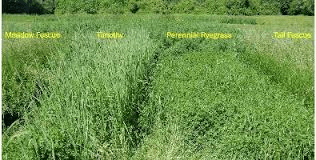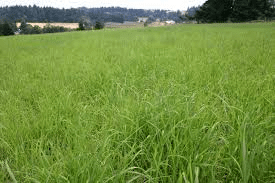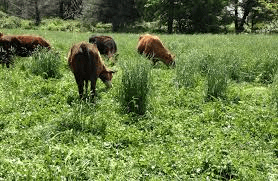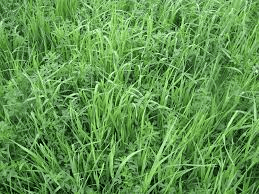Forage grasses are plants that are grown primarily for animal consumption. They form the basis of many livestock diets and play a crucial role in agriculture. Forage grasses not only provide essential nutrients to grazing animals but also help maintain soil health and promote biodiversity.
Understanding forage grasses is important for anyone involved in agriculture, whether you are a farmer, rancher, or simply interested in sustainable practices.
Importance of Forage Grasses in Agriculture
Forage grasses are vital to the agricultural system for several reasons:
1. Livestock Nutrition: Forage grasses provide a primary source of food for livestock, including cattle, sheep, and goats. They supply essential nutrients, proteins, and fibers necessary for animal health and productivity.
2. Soil Health: The deep roots of forage grasses help improve soil structure and reduce erosion. They promote water retention and enhance nutrient cycling, making the soil healthier and more productive.
3. Carbon Sequestration: Forage grasses can capture carbon dioxide from the atmosphere and store it in the soil. This process helps mitigate climate change by reducing greenhouse gases.
4. Biodiversity Support: Diverse forage grass species can support various organisms, including insects and birds, thus enhancing the ecosystem’s health.
5. Economic Benefits: Forage grasses are often more economical to grow than grain crops. They require less input in terms of fertilizers and pesticides, resulting in lower production costs for farmers.
Types of Forage Grasses
There are many types of forage grasses, and they can be broadly categorized into two groups based on their growth habits: cool-season and warm-season grasses.
1. Cool-Season Grasses: These grasses thrive in cooler temperatures, typically growing best in spring and fall. They are more suitable for northern climates. Examples include:
Timothy Grass: This is a popular forage grass known for its palatability and high fiber content. It’s excellent for hay production.
Orchard Grass: Known for its shade tolerance, orchard grass grows well in mixed stands with legumes and provides good forage quality.
Fescue Grass: Tall fescue is hardy and drought-resistant, making it ideal for transitional zones and pastures.
2. Warm-Season Grasses: These grasses thrive in warm temperatures, flourishing in late spring and summer. They are better suited for southern climates. Examples include:
Bermudagrass: This grass is widely used in the southern U.S. for pastures and hay. It has good drought resistance and grows quickly.
Zoysiagrass: This grass forms a dense turf, making it suitable for lawns as well as forage. It is drought-tolerant and grows well in warm areas.
Buffalograss: A native grass that is extremely drought-tolerant and low maintenance, making it ideal for arid regions.
Characteristics of Ideal Forage Grasses

When selecting forage grasses for cultivation, certain characteristics make some grasses more suitable than others. Here are the key traits to look for:
1. Nutritional Value: Nutritional quality is essential. Forage grasses should provide adequate protein, energy, vitamins, and minerals for livestock. High digestibility is also important for better animal health.
2. Palatability: Palatability refers to how much animals like to eat a particular forage. Grasses that are more palatable will encourage higher consumption rates, leading to better animal performance.
3. Yield Potential: Yield potential is important for maximizing forage production. Ideal forage grasses should produce abundant biomass, providing enough feed for the animals throughout the growing season.
4. Persistence: Persistence means how well a grass can survive over time, especially under grazing or cutting. Ideal forage grasses should be able to withstand stress from grazing, drought, and disease.
5. Adaptability: Adaptability to various soil types, climates, and management practices is crucial. The best forage grasses can grow well in different environmental conditions.
Soil Requirements for Forage Grass Cultivation
For successful forage grass cultivation, it is essential to understand the soil requirements. Here are the key factors to consider:
1. Soil Type: Soil type affects how well forage grasses grow. Most grasses prefer well-drained soils with good aeration. Sandy loams or loamy soils are typically ideal.
2. Soil pH: Soil pH is important for nutrient availability. Most forage grasses thrive in a pH range of 6.0 to 7.0. Testing your soil pH can help you determine if you need to adjust it using lime or sulfur.
3. Nutrient Levels: Nutrient levels in the soil should be adequate for healthy grass growth. Key nutrients include nitrogen, phosphorus, and potassium. Soil testing can help you understand your soil’s nutrient profile.
4. Organic Matter: Organic matter improves soil structure and nutrient availability. Incorporating compost or well-rotted manure can enhance soil fertility.
5. Drainage: Good drainage is essential to prevent waterlogging, which can harm forage grasses. If your field has poor drainage, consider installing drainage systems or choosing more tolerant grass species.
Establishing Forage Grass Fields
Creating a successful forage grass field requires careful planning and implementation. Here’s a step-by-step guide to help you establish your forage grass fields effectively.
1. Choose the Right Location: Choose a suitable site for your forage grass field. Look for well-drained soil with good sunlight exposure. Avoid areas that are prone to flooding or have poor drainage.
2. Test the Soil: Conduct a soil test to assess the nutrient levels, pH, and organic matter content. This information will guide you in selecting the right forage species and determining any necessary amendments.
3. Prepare the Seedbed: Prepare the seedbed by removing any weeds, rocks, or debris. You can till the soil to a depth of 4-6 inches to create a loose seedbed. This process helps improve seed-to-soil contact.
4. Select Forage Grass Species: Choose forage grass species that are well-suited for your climate and soil conditions. Consider factors such as nutritional value, growth habit (cool-season vs. warm-season), and drought tolerance.
5. Sow the Seeds: Sow the seeds at the recommended rate, usually 15-30 pounds per acre, depending on the species. Ensure even distribution by using a seed drill or broadcast seeder. Cover the seeds lightly with soil.
6. Watering: Water the newly seeded area adequately, especially during dry periods. Young grasses need consistent moisture for optimal germination and establishment.
7. Fertilization: Apply fertilizers based on your soil test results to provide the necessary nutrients for healthy growth. Follow recommended rates for nitrogen, phosphorus, and potassium.
8. Weed Control: Monitor for weeds during the establishment phase. Implement control measures, such as mowing or herbicides, to prevent competition with your forage grasses.
9. Monitor Growth: Regularly check the growth of your forage grasses. Allow the grasses to establish fully before grazing or cutting for hay, typically around 6-12 inches in height.
10. First Grazing or Harvest: Once established, plan for your first grazing or harvest. Avoid overgrazing to ensure the health of the grass and promote regrowth.
Read Also: 5 Amazing Health Benefits of Triphala (Three fruits)
Management Practices for Forage Grasses

Effective management practices are crucial for maintaining healthy and productive forage grass fields. Here are some key practices to follow:
1. Regular Grazing Management: Implement a rotational grazing system to prevent overgrazing. Move livestock frequently to allow for rest and recovery of the forage grasses.
2. Soil Fertility Management: Monitor soil nutrient levels regularly and apply fertilizers as needed. Maintain optimal nutrient levels to support healthy grass growth.
3. Water Management: Ensure adequate water supply, especially during dry periods. Consider installing irrigation systems if necessary to maintain moisture levels.
4. Pest and Disease Control: Watch for signs of pests and diseases. Implement integrated pest management (IPM) strategies to control issues while minimizing chemical use.
5. Regular Mowing: Mow your forage grasses to encourage healthy growth and prevent seed production. Mowing helps manage weeds and promotes dense grass growth.
6. Soil Erosion Control: Implement practices to prevent soil erosion, such as maintaining ground cover and avoiding overgrazing. This helps protect soil health and structure.
7. Monitor Grass Health: Regularly assess the health of your forage grasses. Look for signs of stress, disease, or nutrient deficiencies, and address them promptly.
Nutritional Value of Forage Grasses
Forage grasses are a crucial part of livestock diets, providing essential nutrients. Here’s a breakdown of their nutritional value:
1. High Fiber Content: Forage grasses are rich in fiber, which is essential for proper digestion in ruminant animals. Fiber helps maintain healthy gut function and promotes satiety.
2. Protein Levels: Different forage grasses have varying protein levels. Legumes mixed with grasses often enhance protein content, which is crucial for growth and milk production in livestock.
3. Vitamins and Minerals: Forage grasses contain essential vitamins and minerals, such as vitamin A, calcium, and phosphorus. These nutrients support overall health and productivity in animals.
4. Energy Sources: While grasses are not as energy-dense as grains, they provide sufficient energy for maintenance and production when consumed in adequate quantities.
5. Digestibility: The digestibility of forage grasses can vary. Generally, younger, leafy grasses are more digestible than older, stemmy varieties. This is why timing of grazing or harvesting is important.
Common Forage Grass Species
Here are some common forage grass species, each with its unique characteristics and benefits:
1. Timothy Grass: Timothy grass is a popular cool-season grass known for its high fiber content and palatability. It’s commonly used in hay production and is suitable for horses.
2. Orchard Grass: Orchard grass thrives in shaded areas and has good palatability. It’s often mixed with legumes for improved nutritional value and is great for grazing.
3. Kentucky Bluegrass: This cool-season grass is well-known for its dense growth and lush appearance. It is ideal for lawns but can also be used for pastures.
4. Bermudagrass: A warm-season grass, Bermudagrass is widely used in southern climates. It grows rapidly and is drought-tolerant, making it excellent for pastures and hay.
5. Tall Fescue: Tall fescue is known for its drought resistance and adaptability. It has a deep root system and can grow in various soil types, making it a reliable forage option.
6. Ryegrass: Perennial ryegrass is a fast-growing cool-season grass that establishes quickly. It is often used for overseeding and provides excellent quality forage.
Read Also: The Effect of Solid Waste on Business Environments
Benefits of Using Forage Grasses in Livestock Feeding

1. Cost-Effectiveness: Forage grasses are often less expensive to grow compared to grains. They require fewer inputs and can yield abundant feed for livestock.
2. Improved Animal Health: A diet rich in forage grasses supports healthy digestion and overall animal well-being. The natural fibers and nutrients contribute to better growth and milk production.
3. Environmental Sustainability: Forage grasses help reduce soil erosion, improve soil health, and enhance biodiversity. They play a crucial role in sustainable farming practices.
4. Reduced Feed Costs: Growing your forage can lower feed costs significantly, allowing farmers to allocate resources more efficiently.
5. Enhanced Soil Fertility: As forage grasses grow and die back, they contribute organic matter to the soil, improving fertility and structure over time.
Forage grasses are essential components of sustainable agriculture. They provide valuable nutrition for livestock, enhance soil health, and contribute to environmental sustainability. Understanding the different types of forage grasses and their characteristics can help you make informed choices for your farming practices.
By selecting the right forage grasses and managing soil health, you can create a thriving pasture that benefits both your livestock and the environment. Proper soil management, including testing pH and nutrient levels, is crucial for successful forage cultivation. With these guidelines, even beginners can cultivate healthy and productive forage grasses for agricultural success.
Do you have any questions, suggestions, or contributions? If so, please feel free to use the comment box below to share your thoughts. We also encourage you to kindly share this information with others who might benefit from it. Since we can’t reach everyone at once, we truly appreciate your help in spreading the word. Thank you so much for your support and for sharing!
Read Also: How Guava Fruits and Leaves Improve Female Fertility
Frequently Asked Questions
We will update this section soon.

